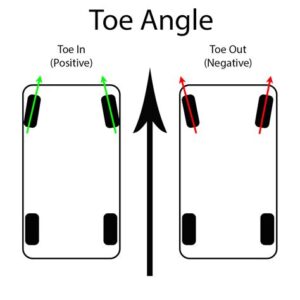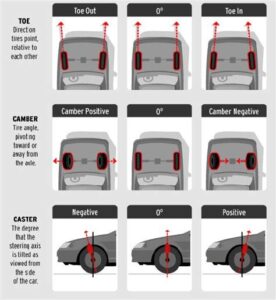Is your car feeling a bit off lately? Proper alignment is crucial for ensuring a smooth ride and optimal performance. If you’ve noticed your vehicle pulling to one side or uneven tire wear, it may be time to investigate further. In this article, we will delve into everything you need to know about car alignment, including common signs that indicate misalignment, how to check it yourself, and the importance of regular alignment checks. Understanding these key elements will not only enhance your driving experience but also extend the lifespan of your vehicle. Stay tuned as we guide you through the essential steps to determine if your car is out of alignment and how to address any issues effectively. Your car’s alignment may be more important than you think!
Understanding Car Alignment: What You Need To Know
Car alignment refers to the adjustment of a vehicle’s suspension system, which connects the wheels to the rest of the vehicle. Proper alignment ensures that the tires make optimal contact with the road and operate efficiently. When a car is in alignment, all four wheels point in the same direction, and the wheels are perpendicular to the road surface. Here are some key aspects to understand:
- Types of Alignment: There are different types of car alignment, including front-end alignment, four-wheel alignment, and thrust alignment. The type depends on your vehicle’s specifications and the issues at hand.
- Components Involved: The main components involved in car alignment are the camber, toe, and caster angles. Each of these is essential for maintaining stability, steering precision, and tire wear.
- Impact on Performance: A well-aligned vehicle not only improves handling but also enhances fuel efficiency. Misalignment can lead to uneven tire wear and reduced lifespan of the tires.
- Indicators of Misalignment: Understanding how to identify misalignment can save you time and money. Some common indicators include uneven tire wear, your car pulling to one side, or the steering wheel being off-center.
Recognizing the significance of car alignment is critical for vehicle maintenance. Regularly checking your alignment, especially after hitting a pothole or curb, can prevent more serious problems down the road. By knowing how to check and address alignment issues promptly, you can ensure a safer and more comfortable driving experience.
Common Signs Indicating Your Car Is Out Of Alignment
Recognizing when your car is out of alignment is crucial for maintaining your vehicle’s performance and safety. Here are some common signs to look out for:
| Sign | Description |
|---|---|
| Uneven Tire Wear | If you notice that your tires are wearing down more on one side than the other, this could be a clear indication of misalignment. |
| Steering Wheel Off Center | When your steering wheel is not centered while driving straight, it may suggest that your wheels are not aligned properly. |
| Pulling to One Side | If your car tends to drift or pull to the left or right while driving on a straight road, this could be a symptom of alignment issues. |
| Vibration in the Steering Wheel | Feeling vibrations in the steering wheel, especially at higher speeds, can be a sign that your car is out of alignment. |
| Noisy Steering | Unusual noises while steering, such as clunking or grinding sounds, can also indicate a problem with alignment or suspension components. |
If you experience any of these signs, it’s essential to take action to ensure your vehicle is aligned correctly. This will not only improve your driving experience but also extend the life of your tires and enhance safety on the road.
How To Check Your Car’s Alignment Yourself
Checking your car’s alignment yourself can be a straightforward process, allowing you to assess whether your vehicle requires professional alignment services. Here are the steps you can follow:
- Find a Level Surface: Start by parking your car on a flat, level surface. This ensures accurate measurements when checking the alignment.
- Measure Your Tire Pressure: Ensure your tires are inflated to the recommended pressure before starting your alignment check. Under-inflated or over-inflated tires can affect the results.
- Check the Tire Wear: Inspect your tires for uneven wear patterns, which could indicate alignment issues. Look for signs of wear on the inner or outer edges of the tires.
- Get a Straight Edge: Take a straight edge, such as a ruler or a plank of wood, and place it against the tires. You can also use alignment tools available for purchase.
- Measure Toe Angle: Use the straight edge to measure the distance between the front and back of your tires. If the front of the tire is closer to the straight edge than the back, your car has a toe-in alignment. If it’s farther away, you have a toe-out alignment.
- Assess Camber Angle: Check the top of the tires against the vertical line of the straight edge. If the tops lean inward or outward, this indicates a camber issue.
- Note Your Findings: Write down your measurements and findings for future reference. This will help you determine if a visit to a mechanic is necessary.
While this method helps you understand how to check your car’s alignment at home, keep in mind that a professional alignment service may still be required for precise adjustments.
The Importance Of Regular Car Alignment Checks
Regular car alignment checks are crucial for maintaining your vehicle’s performance, safety, and longevity. Proper alignment ensures that your tires make even contact with the road, reducing uneven tire wear and enhancing fuel efficiency. Here are some key reasons why you should prioritize regular alignment checks:
| Benefit | Description |
|---|---|
| Tire Longevity | Maintaining proper alignment can significantly extend the life of your tires, saving you money in the long run. |
| Improved Handling | A well-aligned vehicle offers better control, making it easier to steer and navigate, especially in tough driving conditions. |
| Enhanced Fuel Efficiency | Correct alignment reduces rolling resistance, which can lead to improved fuel economy and lower costs at the pump. |
| Safety | Good alignment contributes to overall vehicle safety by ensuring that your car handles as intended, minimizing the risk of accidents. |
Ignoring your vehicle’s alignment can lead to several issues, such as premature tire wear, increased fuel expenses, and potential safety hazards. Therefore, understanding how to detect alignment problems early can save you from costly repairs and enhance your driving experience. Scheduling alignment checks as part of your regular maintenance routine is a smart way to keep your vehicle in top shape.
What To Do If Your Car Is Out Of Alignment
If you suspect that your car is out of alignment, it’s important to take immediate action to prevent further damage and ensure your safety on the road. Here are steps you can follow on how to address the issue:
By following these steps, you can effectively handle a misalignment issue and keep your vehicle running smoothly. Regular maintenance and addressing alignment problems promptly are key to prolonging tire life and enhancing driving safety.
Frequently Asked Questions
What are the signs that indicate my car may be out of alignment?
Common signs include uneven tire wear, the steering wheel being off-center, the car pulling to one side, and a vibrating steering wheel.
How does misalignment affect tire lifespan?
Misalignment causes uneven tire wear, leading to a shorter lifespan for your tires and potentially necessitating premature replacement.
Can I check my car’s alignment at home?
While you can perform some basic checks, such as examining tire wear and steering behavior, a professional alignment check requires specialized equipment.
How often should I check my car’s alignment?
It’s recommended to check your car’s alignment at least once a year or anytime you notice signs of misalignment, such as drifting or uneven tire wear.
What causes a car to go out of alignment?
Common causes include hitting potholes or curbs, natural wear and tear, and accidents that may impact the suspension system.
What type of service is performed during an alignment check?
During an alignment check, a technician will adjust the angles of the wheels so they are positioned correctly relative to each other and the road.
Are there any long-term consequences of driving with misaligned wheels?
Yes, driving with misaligned wheels can lead to increased tire wear, poor handling, and decreased fuel efficiency, which can ultimately cost you more in repairs.





